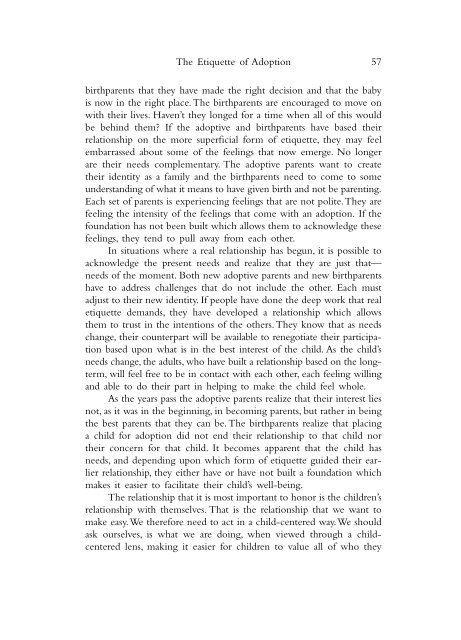Create successful ePaper yourself
Turn your PDF publications into a flip-book with our unique Google optimized e-Paper software.
The Etiquette <strong>of</strong> Adoption<br />
birthparents that <strong>the</strong>y have made <strong>the</strong> right decision and that <strong>the</strong> baby<br />
is now in <strong>the</strong> right place. The birthparents are encouraged to move on<br />
with <strong>the</strong>ir lives. Haven’t <strong>the</strong>y longed for a time when all <strong>of</strong> this would<br />
be behind <strong>the</strong>m? If <strong>the</strong> adoptive and birthparents have based <strong>the</strong>ir<br />
relationship on <strong>the</strong> more superficial form <strong>of</strong> etiquette, <strong>the</strong>y may feel<br />
embarrassed about some <strong>of</strong> <strong>the</strong> feelings that now emerge. No longer<br />
are <strong>the</strong>ir needs complementary. The adoptive parents want to create<br />
<strong>the</strong>ir identity as a family and <strong>the</strong> birthparents need to come to some<br />
understanding <strong>of</strong> what it means to have given birth and not be parenting.<br />
Each set <strong>of</strong> parents is experiencing feelings that are not polite. They are<br />
feeling <strong>the</strong> intensity <strong>of</strong> <strong>the</strong> feelings that come with an adoption. If <strong>the</strong><br />
foundation has not been built which allows <strong>the</strong>m to acknowledge <strong>the</strong>se<br />
feelings, <strong>the</strong>y tend to pull away from each o<strong>the</strong>r.<br />
In situations where a real relationship has begun, it is possible to<br />
acknowledge <strong>the</strong> present needs and realize that <strong>the</strong>y are just that—<br />
needs <strong>of</strong> <strong>the</strong> moment. Both new adoptive parents and new birthparents<br />
have to address challenges that do not include <strong>the</strong> o<strong>the</strong>r. Each must<br />
adjust to <strong>the</strong>ir new identity. If people have done <strong>the</strong> deep work that real<br />
etiquette demands, <strong>the</strong>y have developed a relationship which allows<br />
<strong>the</strong>m to trust in <strong>the</strong> intentions <strong>of</strong> <strong>the</strong> o<strong>the</strong>rs. They know that as needs<br />
change, <strong>the</strong>ir counterpart will be available to renegotiate <strong>the</strong>ir participation<br />
based upon what is in <strong>the</strong> best interest <strong>of</strong> <strong>the</strong> child. As <strong>the</strong> child’s<br />
needs change, <strong>the</strong> adults, who have built a relationship based on <strong>the</strong> longterm,<br />
will feel free to be in contact with each o<strong>the</strong>r, each feeling willing<br />
and able to do <strong>the</strong>ir part in helping to make <strong>the</strong> child feel whole.<br />
As <strong>the</strong> years pass <strong>the</strong> adoptive parents realize that <strong>the</strong>ir interest lies<br />
not, as it was in <strong>the</strong> beginning, in becoming parents, but ra<strong>the</strong>r in being<br />
<strong>the</strong> best parents that <strong>the</strong>y can be. The birthparents realize that placing<br />
a child for adoption did not end <strong>the</strong>ir relationship to that child nor<br />
<strong>the</strong>ir concern for that child. It becomes apparent that <strong>the</strong> child has<br />
needs, and depending upon which form <strong>of</strong> etiquette guided <strong>the</strong>ir earlier<br />
relationship, <strong>the</strong>y ei<strong>the</strong>r have or have not built a foundation which<br />
makes it easier to facilitate <strong>the</strong>ir child’s well-being.<br />
The relationship that it is most important to honor is <strong>the</strong> children’s<br />
relationship with <strong>the</strong>mselves. That is <strong>the</strong> relationship that we want to<br />
make easy. We <strong>the</strong>refore need to act in a child-centered way. We should<br />
ask ourselves, is what we are doing, when viewed through a childcentered<br />
lens, making it easier for children to value all <strong>of</strong> who <strong>the</strong>y<br />
57
















